Comparing Rust Actor Libraries: Actix, Coerce, Kameo, Ractor, and Xtra
Posted January 17, 2025 by Ari Seyhun ‐ 8 min read
Introduction
Rust’s actor ecosystem is flourishing with multiple libraries offering unique approaches to concurrency and distributed system design. This post shares the results of a benchmarking study comparing the performance and features of five popular Rust actor libraries:
Why Benchmark These Libraries?
The primary objective is to evaluate throughput and latency under realistic workloads. By assessing message passing efficiency and actor creation speed, we can better understand the trade-offs each library makes. Although each library caters to different use cases (e.g., distributed environments, supervision, etc.), this benchmarking study provides a starting point for developers choosing an actor library in Rust.
Benchmarking Overview
Libraries Compared
Below are the latest stable releases of the libraries tested:
- Actix – A mature framework that uses its own runtime (“Actix runtime”) which is built on Tokio.
- Coerce – Built atop Tokio, offering distributed actors.
- Kameo – Also uses Tokio, focusing on both local and distributed scenarios.
- Ractor – Relies on Tokio, with support for Async Std, distribution and fault tolerance.
- Xtra – Supports multiple runtimes (Async Std, Smol, Tokio, Wasm Bindgen).
Hardware & Software Setup
- Machine: MacBook Pro (2.4 GHz 8-Core Intel Core i9, 32 GB memory)
- Rust: 1.84.0
- Benchmarking Tool: Criterion.rs
Goals & Metrics
-
Messaging Throughput & Latency
- This involves “tell requests” (fire-and-forget) to 100 spawned actors in a round-robin fashion.
- Measure how quickly the system processes a specified number of messages.
-
Actor Creation Speed
- Measure how quickly each library can spawn and initialize a set of actors.
-
Additional Criteria
- Runtime Used: Does the library rely on Tokio, a custom runtime, or another option?
- Fault Tolerance & Distributed Communication: Not benchmarked, but compared with eachother in the feature comparison table.
Fairness & Transparency
Despite being the author of kameo, all libraries were benchmarked using their default configurations. No library received special optimizations. The complete benchmark code is open-sourced at:
Feature Comparison
Below is a high-level overview of each library’s capabilities, including mailbox configurations, supervision, and distributed actors:
| Feature | Actix | Coerce | Kameo | Ractor | Xtra |
|---|---|---|---|---|---|
| Bounded Mailboxes | ✅ | ❌ | ✅ | ❌ | ✅ |
| Unbounded Mailboxes | ❌ | ✅ | ✅ | ✅ | ✅ |
| Ask Requests (Message + Reply) | ✅ | ✅ | ✅ | ✅ | ✅ |
| Tell Requests (Fire and Forget) | ✅ | ✅ | ✅ | ✅ | ✅ |
| Supervision | ✅ | ✅ | ✅ | ✅ | ❌ |
| Distributed Actors | ❌ | ✅ | ✅ | ✅ | ❌ |
| Runtime Used | Actix | Tokio | Tokio | Async Std Tokio | Async Std Smol Tokio Wasm Bindgen |
| Latest Release | Jun, 2024 | Oct, 2023 | Mar, 2025 | Feb, 2025 | Feb, 2024 |
Benchmark Scenarios
-
Message Passing Efficiency
- Scenario: Spawn 100 actors, send a round-robin series of “tell requests” (fire-and-forget) to each actor, and measure the time per message.
- Rationale: This test more realistically simulates real-world concurrency than sending messages to a single actor.
-
Actor Creation Speed
- Scenario: Measure the time to spawn a batch of actors.
- Rationale: Certain applications may dynamically scale the number of actors based on load, making spawn time a crucial factor.
-
Fault Tolerance & Distributed Communication
- Scenario: Reviewed capabilities and performance, but not graphed.
- Rationale: Some libraries focus heavily on distribution (Coerce, Kameo, Ractor), while others (Actix, Xtra) prioritize simpler local concurrency or user flexibility with different runtimes.
Benchmark Results
Messaging Time per Request
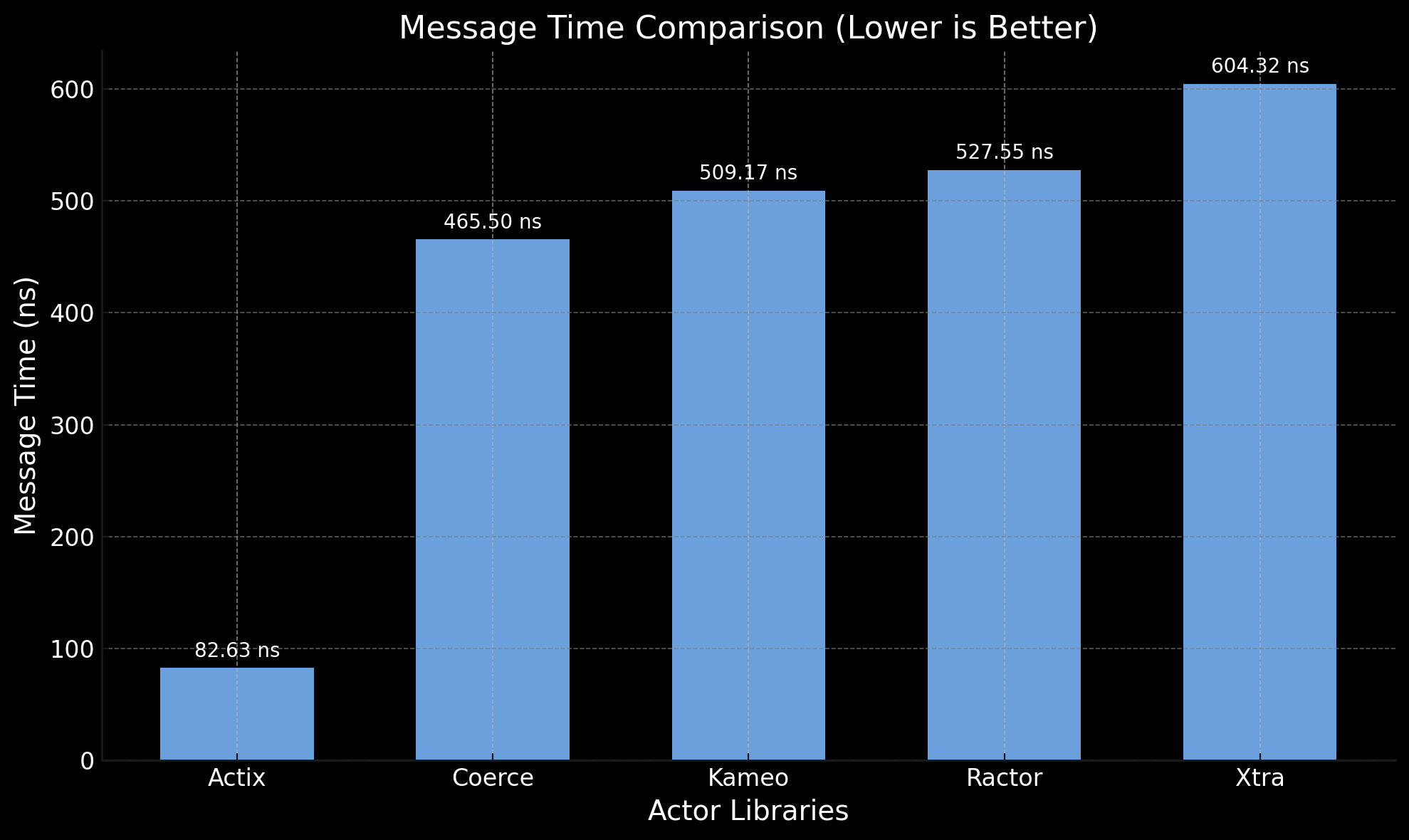
- Actix: Provides the fastest messaging speeds, benefiting from its runtime and internal optimizations.
- Coerce, Kameo, Ractor: Provides very similar performance for messaging.
- Xtra: Performance can vary slightly depending on which runtime is chosen (Tokio, Async Std, etc.). But for tokio, the results are very similar to the other three libraries.
Actor Spawn Time
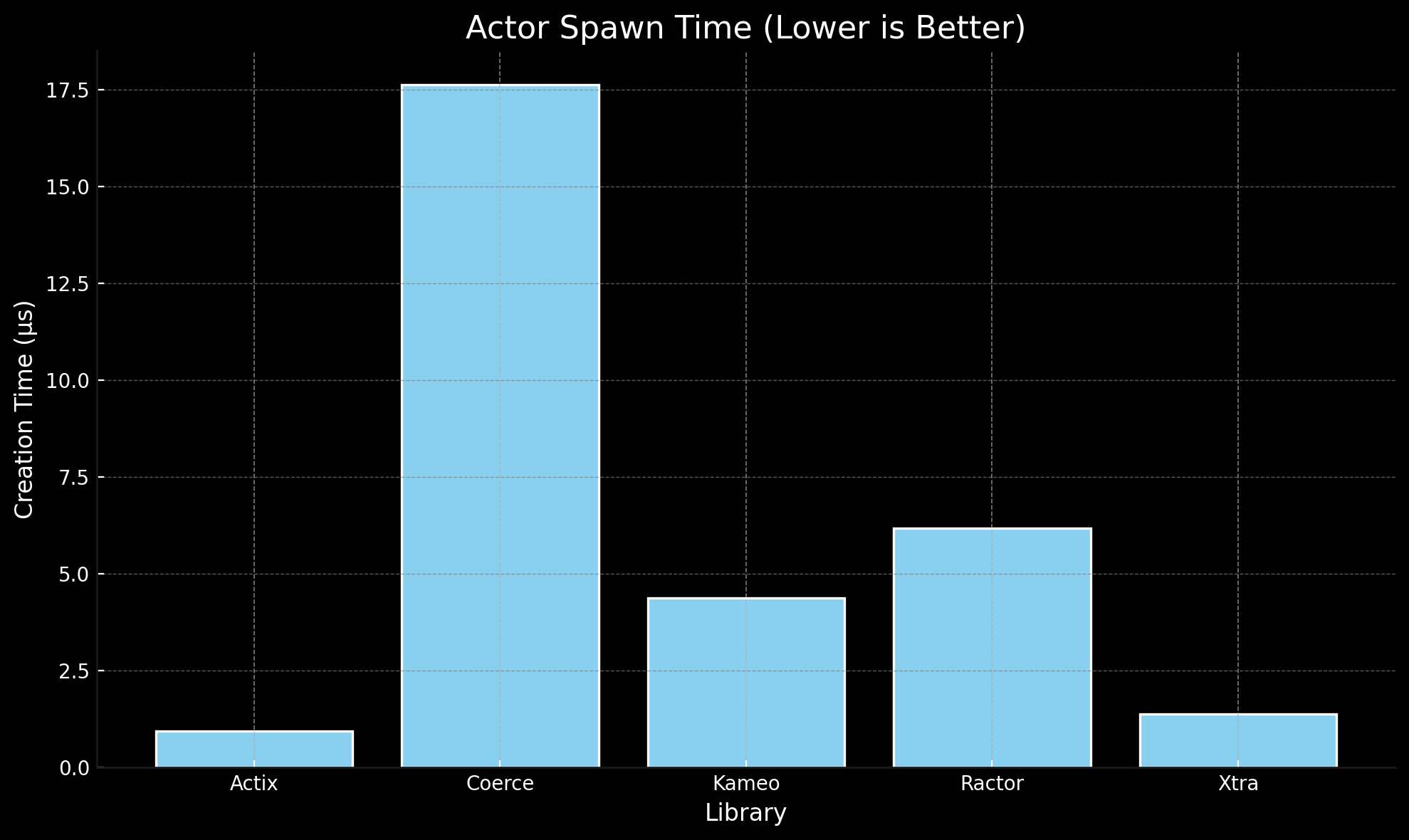
- Actix: Fastest actor spawning.
- Coerce: Highest actor spawning time, possibly due to additional features.
- Kameo: Comparable to other Tokio-based libraries, maintaining a good balance of features.
- Ractor: Stays close to Kameo’s performance in actor creation.
- Xtra: Spawns quickly, though the chosen runtime can affect results. This benchmark uses tokio.
Spawning an Actor
Here we'll compare each libraries bare minimum code for defining an spawning an actor without the use of macros.
Lines of code excludes empty lines, and assumes the code is formatted with rustfmt.
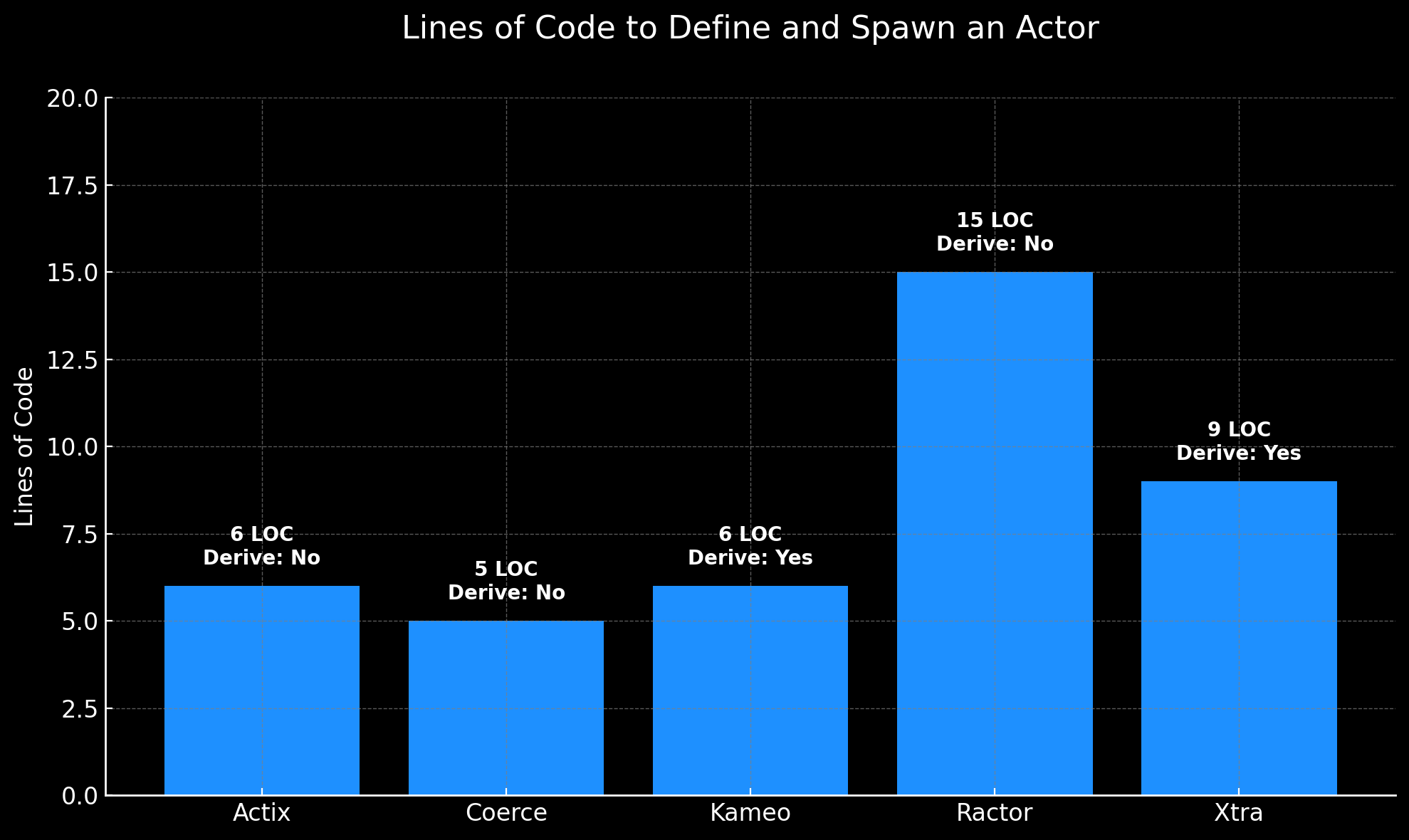
Actix
- Derive macro support: ❌
- Lines of code: 6
use actix::{Actor, Context};
struct MyActor;
impl Actor for MyActor {
type Context = Context<Self>;
}
MyActor.start();
Coerce
- Derive macro support: ❌
- Lines of code: 5
use coerce::actor::Actor;
struct MyActor;
impl Actor for MyActor {}
let system = ActorSystem::new();
MyActor.into_actor(Some("my-actor"), &system).await?;
Kameo
- Derive macro support: ✅
- Lines of code: 6
use kameo::{Actor, error::Infallible};
struct MyActor;
impl Actor for MyActor {
type Error = Infallible;
}
kameo::spawn(MyActor);
Ractor
- Derive macro support: ❌
- Lines of code: 15
use ractor::{Actor, ActorProcessingErr};
struct MyActor;
impl Actor for MyActor {
type Msg = ();
type State = ();
type Arguments = ();
async fn pre_start(
&self,
myself: ActorRef<Self::Msg>,
args: Self::Arguments
) -> Result<Self::State, ActorProcessingErr> {
Ok(())
}
}
Actor::spawn(None, MyActor, ()).await?;
Xtra
- Derive macro support: ✅
- Lines of code: 9
use xtra::{Actor, Mailbox};
struct MyActor;
impl Actor for MyActor {
type Stop = ();
async fn stopped(self) -> Self::Stop {
()
}
}
xtra::spawn_tokio(MyActor, Mailbox::unbounded());
Messaging an Actor
Next we'll compare each libraries bare minimum code for defining and sending a message to an actor without a reply, also without the use of macros.
Lines of code excludes empty lines, and assumes the code is formatted with rustfmt.
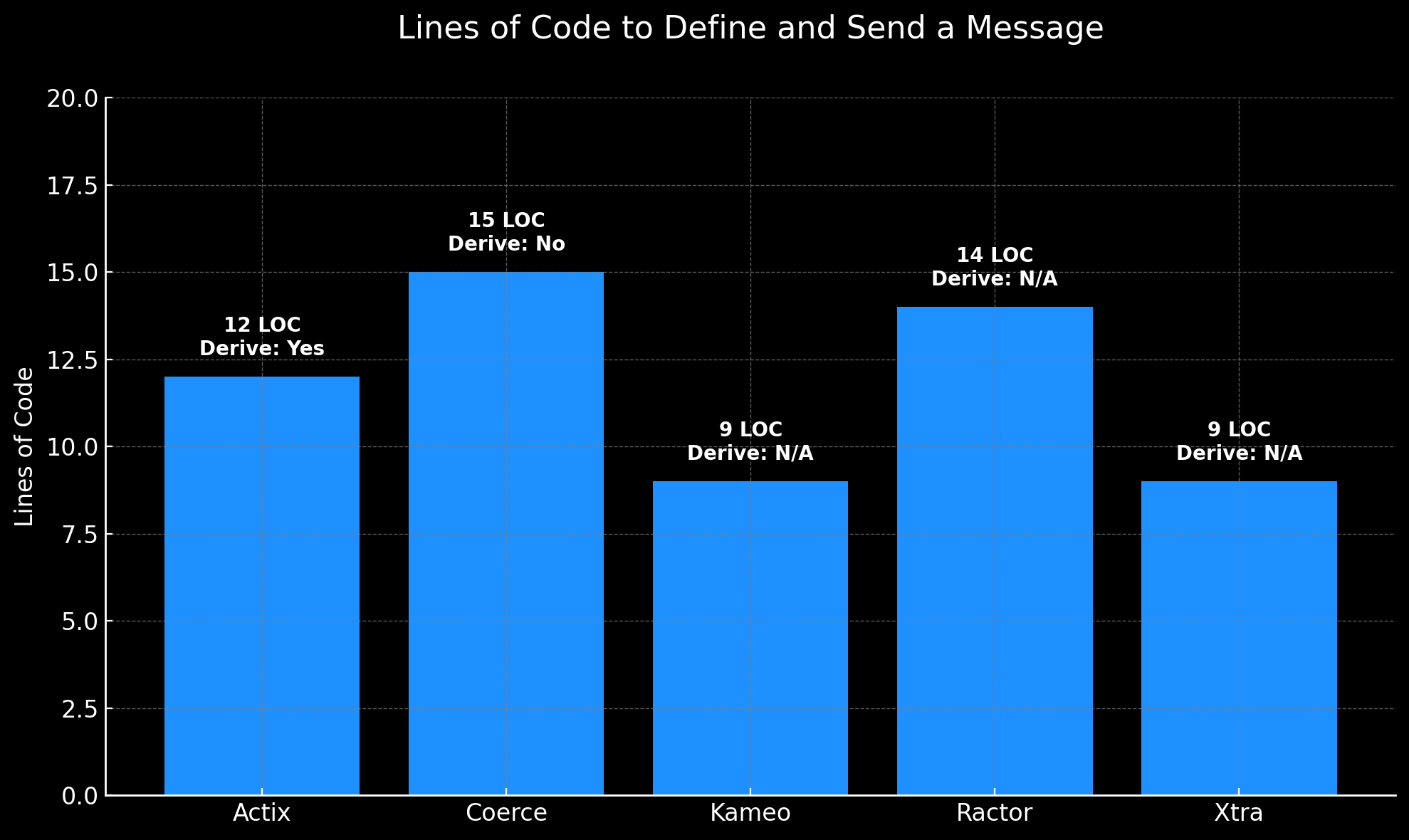
Actix
- Derive macro support: ✅ for
Message - Lines of code: 12
use actix::{Handler, Message};
struct MyMsg;
impl Message for MyMsg {
type Result = ();
}
impl Handler<MyMsg> for MyActor {
type Result = ();
fn handle(&mut self, msg: (), ctx: &mut Self::Context) -> Self::Result {
()
}
}
actor_ref.do_send(MyMsg);
Coerce
- Derive macro support: ❌
- Lines of code: 15
use coerce::actor::{
context::ActorContext,
message::{Handler, Message},
};
struct MyMsg;
impl Message for MyMsg {
type Result = ();
}
#[async_trait::async_trait]
impl Handler<MyMsg> for MyActor {
async fn handle(&mut self, msg: MyMsg, _ctx: &mut ActorContext) -> () {
()
}
}
actor_ref.notify(MyMsg)?;
Kameo
- Derive macro support: Not needed
- Lines of code: 9
use kameo::message::{Context, Message};
struct MyMsg;
impl Message<MyMsg> for MyActor {
type Reply = ();
async fn handle(&mut self, msg: MyMsg, _ctx: &mut Context<Self, Self::Reply>) -> Self::Reply {
()
}
}
actor_ref.tell(MyMsg).await?;
Ractor
Ractor's message handling is done in the Actor implementation.
Additionally, ractor messages are typically a single enum.
- Derive macro support: Not needed
- Lines of code: ~14
use ractor::{Actor, ActorProcessingErr, ActorRef};
struct MyMsg;
impl Actor for MyActor {
type Msg = MyMsg;
// ...
async fn handle(
&self,
myself: ActorRef<Self::Msg>,
message: Self::Msg,
state: &mut Self::State,
) -> Result<(), ActorProcessingErr> {
Ok(())
}
}
actor_ref.cast(MyMsg)?;
Xtra
- Derive macro support: Not needed
- Lines of code: 9
use xtra::{Context, Handler};
struct MyMsg;
impl Handler<MyMsg> for MyActor {
type Return = ();
async fn handle(&mut self, msg: MyMsg, _ctx: &mut Context<Self>) -> Self::Return {
()
}
}
actor_ref.send(MyMsg).detach().await?;
Observations and Trade-Offs
-
Bounded vs. Unbounded Mailboxes
- Some libraries only support one type of mailbox, while others support both.
-
Fault Tolerance & Distributed Communication
- Kameo, Coerce, and Ractor include built-in distribution features.
- Actix can be extended with external crates for distributed capabilities but doesn’t ship them by default.
- Xtra supports only local concurrency with no distributed capabilities.
-
Runtime Considerations
- Coerce and Kameo rely on Tokio for concurrency.
- Actix uses its own runtime, which is a layer built on Tokio.
- Ractor supports 2 runtimes, and Xtra support 4 runtimes.
-
Real-World Use Cases
- While these benchmarks provide valuable insights, real-world performance may differ.
- Users are encouraged to prototype and measure within their specific application context.
Overall Scores
Assigning a basic score based on the feature table, and smallest LOC for defining and spawning/messaging an actor, here are the results:
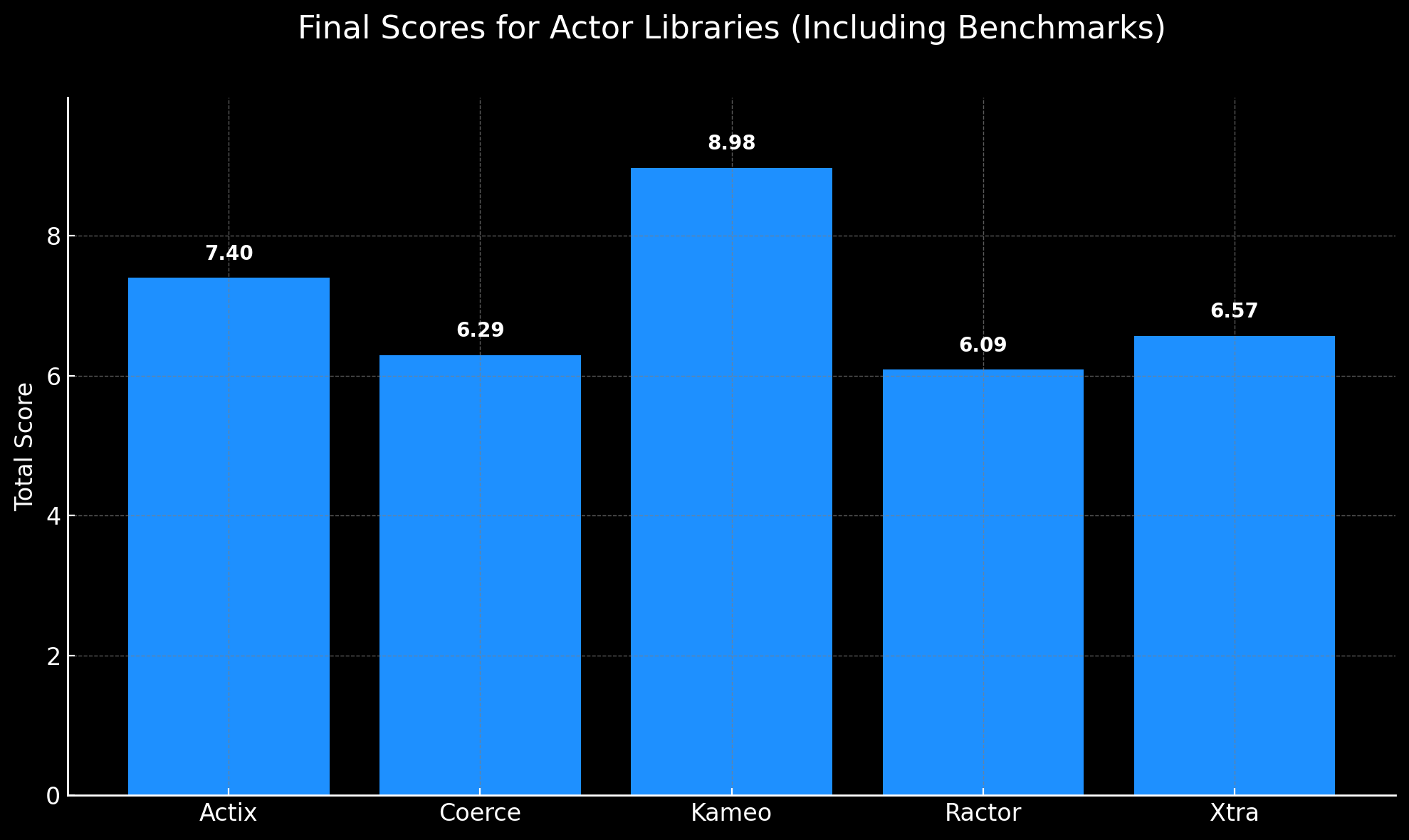
| Library | Feature Score | Spawn Score | Message Score | LOC Spawning Score | LOC Messaging Score | Total Score |
|---|---|---|---|---|---|---|
| Actix | 4.00 | 1.00 | 1.00 | 0.90 | 0.50 | 7.40 |
| Coerce | 5.00 | 0.00 | 0.29 | 1.00 | 0.00 | 6.29 |
| Kameo | 6.00 | 0.79 | 0.28 | 0.90 | 1.00 | 8.98 |
| Ractor | 5.00 | 0.69 | 0.23 | 0.00 | 0.17 | 6.09 |
| Xtra | 4.00 | 0.97 | 0.00 | 0.60 | 1.00 | 6.57 |
Conclusion
Choosing the right actor library in Rust depends on factors like mailbox type, performance requirements, runtime integration, and whether you need out-of-the-box distribution. Here’s a concise summary:
- Actix excels at local concurrency, offering robust documentation and fast actor creation. However its async support is an afterthought, and not the smoothest experience when compared to other actor libraries.
- Coerce is specialized for distributed systems on top of Tokio.
- Kameo balances local and distributed needs with solid performance, easy-to-use APIs, and supervision built-in.
- Ractor is another viable choice for distributed actor systems with a simpler design. However, it is the only library which only supports a single message type per actor, encouraging the use of enum messages, which may not be desirable for some.
- Xtra provides flexible runtime options and is well-suited for projects seeking a more minimal actor framework.
Ultimately, the best library for your project will depend on your exact requirements. If you need straightforward concurrency, Actix or Xtra might suffice. If you need built-in distribution without much extra configuration, Kameo, Coerce, or Ractor may be more appealing.
Access the Full Benchmark Suite
All benchmark code, configurations, and raw results are open-sourced:
Please feel free to clone, run, and submit pull requests. Community contributions are welcome and encouraged.
Next Steps & Community Feedback
- Try It Out: Test each actor library within your own environment or workload.
- Contribute: PRs to enhance the benchmark suite or to optimize any library configurations are very welcome.
- Discuss: Share your findings, experiences, and questions in the Rust community (e.g., Reddit, Discord, GitHub Discussions), alternatively feel free to share findings in the comments of this blog.
Final Thoughts
These benchmarks represent a snapshot of the Rust actor ecosystem as of early 2025. Libraries continue to evolve, and performance may improve over time. If you’re seeking a flexible, scalable, and fault-tolerant actor framework, as the author of Kameo, I genuienly think is one of the top choices for new apps—particularly if you value built-in distributed functionality and strong integration with Tokio. However, every library in this comparison has its merits, and the “best” one ultimately depends on your project’s unique needs.
Thank you for reading, and happy building with Rust actors!